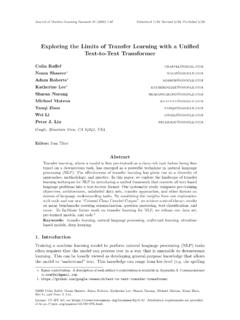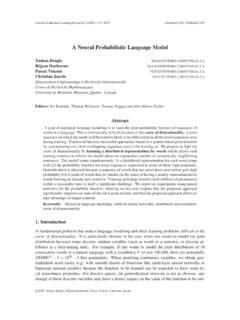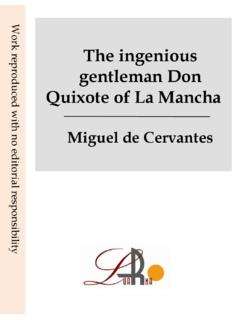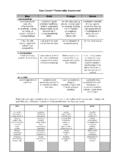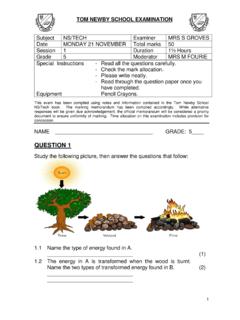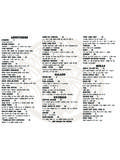Transcription of A Neural Probabilistic Language Model
1 Journal of Machine Learning Research 3 (2003) 1137 1155 Submitted 4/02; Published 2/03A Neural Probabilistic Language ModelYoshua jean partement d Informatique et Recherche Op rationnelleCentre de Recherche Math matiquesUniversit de Montr al, Montr al, Qu bec, CanadaEditors:Jaz Kandola, Thomas Hofmann, Tomaso Poggio and John Shawe-TaylorAbstractA goal of statistical Language modeling is to learn the joint probability function of sequences ofwords in a Language . This is intrinsically difficult because of thecurse of dimensionality:awordsequence on which the Model will be tested is likely to be different from all the word sequences seenduring training. Traditional but very successful approaches based on n-grams obtain generalizationby concatenating very short overlapping sequences seen in the training set. We propose to fight thecurse of dimensionality bylearning a distributed representation for wordswhich allows eachtraining sentence to inform the Model about an exponential number of semantically neighboringsentences.
2 The Model learns simultaneously (1) a distributed representation for each word alongwith (2) the probability function for word sequences, expressed in terms of these is obtained because a sequence of words that has never been seen before gets highprobability if it is made of words that are similar (in the sense of having a nearby representation) towords forming an already seen sentence. Training such large models (with millions of parameters)within a reasonable time is itself a significant challenge. We report on experiments using neuralnetworks for the probability function, showing on two text corpora that the proposed approachsignificantly improves on state-of-the-art n-gram models, and that the proposed approach allows totake advantage of longer :Statistical Language modeling, artificial Neural networks, distributed representation,curse of dimensionality1.
3 IntroductionA fundamental problem that makes Language modeling and other learning problems difficult is thecurse of dimensionality. It is particularly obvious in the case when one wants to Model the jointdistribution between many discrete random variables (such as words in a sentence, or discrete at-tributes in a data-mining task). For example, if one wants to Model the joint distribution of 10consecutive words in a natural Language with a vocabularyVof size 100,000, there are potentially100 00010 1=1050 1 free parameters. When modeling continuous variables, we obtain gen-eralization more easily ( with smooth classes of functions like multi-layer Neural networks orGaussian mixture models) because the function to be learned can be expected to have some lo-cal smoothness properties. For discrete spaces, the generalization structure is not as obvious: anychange of these discrete variables may have a drastic impact on the value of the function to be esti-c 2003 Yoshua Bengio, R jean Ducharme, Pascal Vincent, Christian ,DUCHARME,VINCENT ANDJAUVIN mated, and when the number of values that each discrete variable can take is large, most observedobjects are almost maximally far from each other in hamming useful way to visualize how different learning algorithms generalize, inspired from the view ofnon-parametric density estimation, is to think of how probability mass that is initially concentratedon the training points ( , training sentences) is distributed in a larger volume, usually in some formof neighborhood around the training points.
4 In high dimensions, it is crucial to distribute probabilitymass where it matters rather than uniformly in all directions around each training point. We willshow in this paper that the way in which the approach proposed here generalizes is fundamentallydifferent from the way in which previous state-of-the-art statistical Language modeling approachesare statistical Model of Language can be represented by the conditional probability of the nextword given all the previous ones, since P(wT1)=T t=1 P(wtjwt 11),wherewtis thet-th word, and writing sub-sequencewji=(wi,wi+1, ,wj 1,wj). Such statisti-cal Language models have already been found useful in many technological applications involvingnatural Language , such as speech recognition, Language translation, and information retrieval. Im-provements in statistical Language models could thus have a significant impact on such building statistical models of natural Language , one considerably reduces the difficultyof this modeling problem by taking advantage of word order, and the fact that temporally closerwords in the word sequence are statistically more dependent.
5 Thus,n-grammodels construct ta-bles of conditional probabilities for the next word, for each one of a large number ofcontexts, of the lastn 1 words: P(wtjwt 11) P(wtjwt 1t n+1).We only consider those combinations of successive words that actually occur in the training cor-pus, or that occur frequently enough. What happens when a new combination ofnwords appearsthat was not seen in the training corpus? We do not want to assign zero probability to such cases,because such new combinations are likely to occur, and they will occur even more frequently forlarger context sizes. A simple answer is to look at the probability predicted using a smaller contextsize, as done in back-off trigram models (Katz, 1987) or in smoothed (or interpolated) trigram mod-els (Jelinek and Mercer, 1980). So, in such models, how is generalization basically obtained fromsequences of words seen in the training corpus to new sequences of words?
6 A way to understandhow this happens is to think about a generative Model corresponding to these interpolated or back-off n-gram models. Essentially, a new sequence of words is generated by gluing very short andoverlapping pieces of length 1, 2 .. or up tonwords that have been seen frequently in the trainingdata. The rules for obtaining the probability of the next piece are implicit in the particulars of theback-off or interpolated n-gram algorithm. Typically researchers have usedn=3, trigrams,and obtained state-of-the-art results, but see Goodman (2001) for how combining many tricks canyield to substantial improvements. Obviously there is much more information in the sequence thatimmediately precedes the word to predict than just the identity of the previous couple of are at least two characteristics in this approach which beg to be improved upon, and that we1138 ANEURALPROBABILISTICLANGUAGEMODEL will focus on in this paper.
7 First, it is not taking into account contexts farther than 1 or 2 words,1second it is not taking into account the similarity between words. For example, having seen thesentence The cat is walking in the bedroom in the training corpus should help us gener-alize to make the sentence A dog was running in a room almost as likely, simply because dog and cat (resp. the and a , room and bedroom , ) have similar semantic andgrammatical are many approaches that have been proposed to address these two issues, and we willbriefly explain in Section the relations between the approach proposed here and some of theseearlier approaches. We will first discuss what is the basic idea of the proposed approach. A moreformal presentation will follow in Section 2, using an implementation of these ideas that relieson shared-parameter multi-layer Neural networks.
8 Another contribution of this paper concerns thechallenge of training such very large Neural networks (with millions of parameters) for very largedata sets (with millions or tens of millions of examples). Finally, an important contribution ofthis paper is to show that training such large-scale Model is expensive but feasible, scales to largecontexts, and yields good comparative results (Section 4).Many operations in this paper are in matrix notation, with lower casevdenoting a column vectorandv0its transpose,Ajthej-th row of a matrixA, Fighting the Curse of Dimensionality with Distributed RepresentationsIn a nutshell, the idea of the proposed approach can be summarized as follows:1. associate with each word in the vocabulary a distributedword feature vector(a real-valued vector inRm),2. express the jointprobability functionof word sequences in terms of the feature vectorsof these words in the sequence, and3.
9 Learn simultaneously theword feature vectorsand the parameters of feature vector represents different aspects of the word: each word is associated with a pointin a vector space. The number of features ( , 60 or 100 in the experiments) is muchsmaller than the size of the vocabulary ( 17,000). The probability function is expressed as aproduct of conditional probabilities of the next word given the previous ones, ( using a multi-layer Neural network to predict the next word given the previous ones, in the experiments). Thisfunction has parameters that can be iteratively tuned in order tomaximize the log-likelihood ofthe training dataor a regularized criterion, by adding a weight decay featurevectors associated with each word are learned, but they could be initialized using prior knowledgeof semantic does it work? In the previous example, if we knew thatdogandcatplayed simi-lar roles (semantically and syntactically), and similarly for (the,a), (bedroom,room), (is,was),1.
10 N-grams withnup to 5 ( 4 words of context) have been reported, though, but due to data scarcity, most predictionsare made with a much shorter Like in ridge regression, the squared norm of the parameters is ,DUCHARME,VINCENT ANDJAUVIN(running,walking), we could naturally generalize ( transfer probability mass) fromThe cat is walking in the bedroomtoA dog was running in a roomand likewise toThe cat is running in a roomA dog is walking in a bedroomThe dog was walking in the many other combinations. In the proposed Model , it will so generalize because similar wordsare expected to have a similar feature vector, and because the probability function is asmoothfunction of these feature values, a small change in the features will induce a small change in theprobability. Therefore, the presence of only one of the above sentences in the training data will in-crease the probability, not only of that sentence, but also of its combinatorial number of neighbors in sentence space (as represented by sequences of feature vectors).

